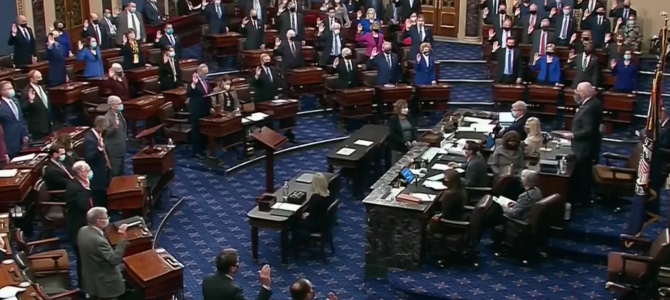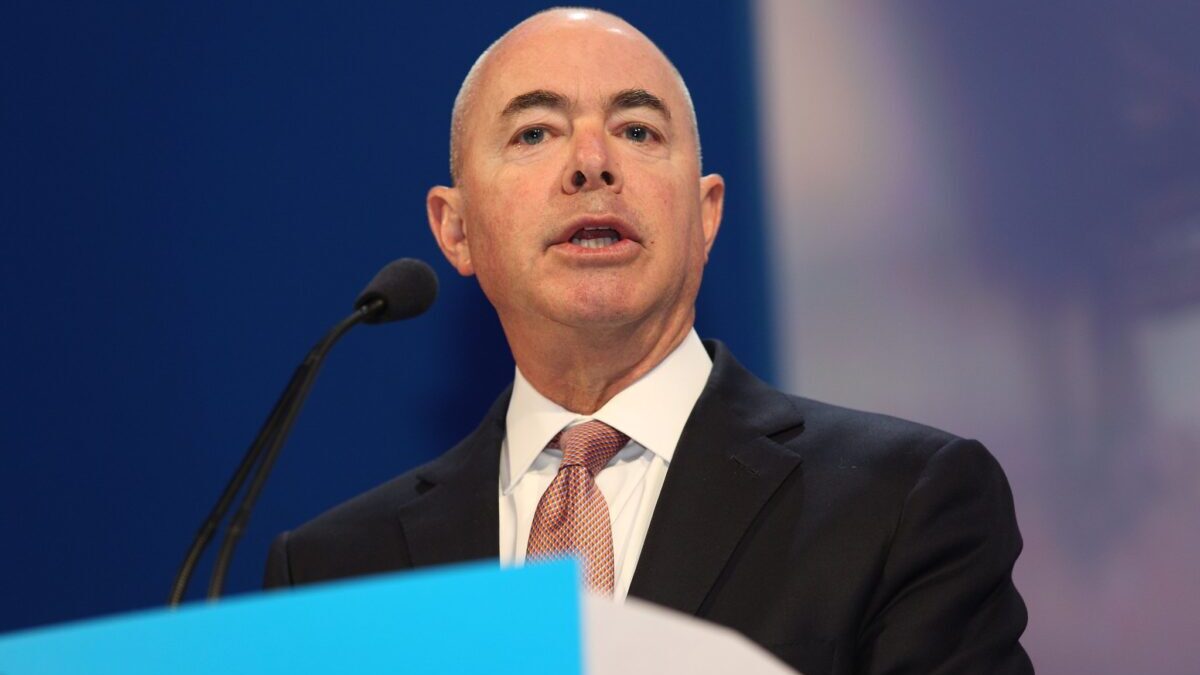
President Donald Trump was acquitted by a comfortable margin in a second Senate impeachment trial Saturday, marking the final end of a five-year campaign by Democrats to achieve the top item on their agenda before, during, and after Trump’s one-term presidency.
The Democrats’ charged the outgoing president with “incitement of insurrection” in the latest impeachment saga, passing the article in the House in a snap maneuver absent a single hearing or witness within a week of the riots at the Capitol.
“Donald Trump is a clear and present danger to our country and that once again we honor that oath of office to protect and defend the Constitution of the United States, so help us God,” House Speaker Nancy Pelosi said as she signed the article of impeachment. But her words rang cheap as she declared a man with seven days left in office to be a “clear and present danger,” and they rang even cheaper when considering Americans had heard the endless hyperbolic rhetoric before.
Trump was declared a “clear and present danger” by political opponents from the moment he assumed office, with the Washington Post headlining: “The campaign to impeach President Trump has begun” mere minutes after he was sworn into office.
The Democrats’ first impeachment, launched after the grand failure of the Russian collusion hoax in 2019 — which still carried baseless accusations with it through the 2020 election — focused on the president’s summer phone call with the president of Ukraine. Democrats accused Trump of illegally leveraging $400 million in military aid to secure a Ukrainian investigation into the Biden family’s business dealings in an apparent quid pro quo. The released transcript of the phone call, however, revealed no such arrangement and only revealed Trump placing appropriate pressure on the Ukrainians to rid the government of corruption and investigate the origins of its role in peddling the Russia hoax, which reaped irreparable harm on U.S. institutions.
Democrats pushed forward, however, impeaching the president on “high crimes and misdemeanors.” Those proceedings featured months of hearings and witnesses across two House committees and a Senate trial, conducted while the novel Wuhan coronavirus brewed overseas. Trump was ultimately exonerated in the upper chamber with only 48 senators supporting a guilty verdict. Sixty-seven votes are needed to convict.
A new wave of incriminating evidence surrounding the Biden family’s overseas business ventures surfaced during the fall presidential campaign and further exposed the Democrats’ first impeachment trial as a sham.
The Democrats’ second impeachment, launched in the first days of 2021, emerged as a snap reaction to the riots at the Capitol in January. The case for impeaching Trump was so weak, in fact, that the Democrats fabricated evidence to secure a conviction that still never came while Chief Justice John Roberts refused to preside over the trial.
Trump, so went the tale, rallied his supporters at the White House on Jan. 6 and explicitly demanded they storm the Capitol to halt certification of the Electoral College votes that would hand the keys to the White House over to Joe Biden.
A timeline of events that day, however, shows the riot at the Capitol began 20 minutes before Trump even finished speaking more than a mile and a half away. Further, Trump offered no calls for his supporters to violently take over the historic building and demanded that his followers protest “peacefully.”
“I know that everyone here will soon be marching over to the Capitol building to peacefully and patriotically make your voices heard,” Trump told his supporters gathered near the White House. “Today we will see whether Republicans stand strong for integrity of our elections.”
Democrats seized on a portion of Trump’s speech in which the president issued calls for supporters to “fight like hell,” political rhetoric commonly used by Democrats themselves, who have routinely gone further in explicitly calling on their own supporters to harass members of the Trump administration and riot in the streets under the moral righteousness of social justice.
Democrats ended the second round of impeachment proceedings in an array of procedural confusion when the House managers secured a vote to green-light witnesses — and then proceeded straight to closing arguments without calling any witnesses.
A New York Times correction quietly issued as the trial came to a close further embarrassed Democrats by exposing that the House impeachment managers used fabricated evidence.
In their pretrial memo, Democrats claimed that “insurrectionists killed a Capitol police officer by striking him in the head with a fire extinguisher.” This claim stemmed from a New York Times article first published two days after the Capitol riot, headlined “Capitol Police Officer Dies From Injuries in Pro-Trump Rampage.” The Times, however, didn’t issue any updates from subsequent reporting that debunked its primary assertion until Feb. 16.
“New information has emerged regarding the death of the Capitol Police officer Brian Sicknick that questions the initial cause of his death provided by officials close to the Capitol police,” now reads a note pinned to the top of the page.
A CNN report published on Feb. 2 cites investigators reporting that it’s unclear why the officer in question collapsed the night of the riots, but they failed to find signs the officer “sustained any blunt force trauma,” let alone by a fire extinguisher, as Democrats claimed.
Democrats also rescinded comments attributed to Republican Utah Sen. Mike Lee after the western senator objected to what impeachment managers had included in the record. House Democrats tried to create a narrative that Trump had demanded that senators continue making objections to the Electoral College certification while the Capitol riot ensued.
The second impeachment trial was nothing but an embarrassing political ploy by the Democrats to punish Republican opponents by capitalizing on the outbreak of right-wing violence in early January — an outbreak roundly condemned by Republicans but weaponized by the left to seek retribution anyway.









